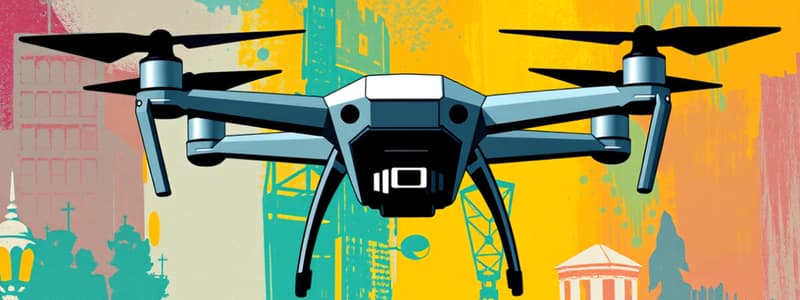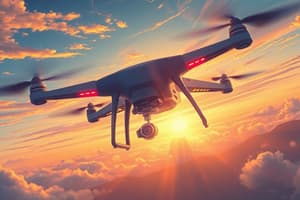Podcast
Questions and Answers
After receiving a part 107 remote pilot certificate with an sUAS rating, how often must you satisfy recurrent training requirements?
After receiving a part 107 remote pilot certificate with an sUAS rating, how often must you satisfy recurrent training requirements?
Within 24 calendar months
According to 14 CFR part 107, an sUAS is an unmanned aircraft system weighing:
According to 14 CFR part 107, an sUAS is an unmanned aircraft system weighing:
Less than 55 lbs
Unmanned aircraft means an aircraft operated:
Unmanned aircraft means an aircraft operated:
Without the possibility of direct human intervention from within or on the aircraft
Which of the following types of operations are excluded from the requirements in part 107?
Which of the following types of operations are excluded from the requirements in part 107?
Which of the following operations require adherence to 14 CFR 107?
Which of the following operations require adherence to 14 CFR 107?
According to 14 CFR part 48, when would a small unmanned aircraft owner not be permitted to register it?
According to 14 CFR part 48, when would a small unmanned aircraft owner not be permitted to register it?
All small unmanned aircraft must be registered before operation in the National Airspace System (NAS).
All small unmanned aircraft must be registered before operation in the National Airspace System (NAS).
When using a small unmanned aircraft in a non-recreational operation, who is responsible for informing the participants about emergency procedures?
When using a small unmanned aircraft in a non-recreational operation, who is responsible for informing the participants about emergency procedures?
A person without a part 107 remote pilot certificate may operate an sUAS for non-recreational operations:
A person without a part 107 remote pilot certificate may operate an sUAS for non-recreational operations:
A person whose sole task is watching the sUAS to report hazards to the rest of the crew is called:
A person whose sole task is watching the sUAS to report hazards to the rest of the crew is called:
The effective use of all available resources—human, hardware, and information—prior to and during flight to ensure the successful outcome of the operation is called:
The effective use of all available resources—human, hardware, and information—prior to and during flight to ensure the successful outcome of the operation is called:
When adapting crew resource management (CRM) concepts to the operation of a small unmanned aircraft, CRM must be integrated into:
When adapting crew resource management (CRM) concepts to the operation of a small unmanned aircraft, CRM must be integrated into:
You have been hired as a Remote Pilot in Command by a local TV news station to film breaking news. You expressed a safety concern and the station manager has instructed you to 'hurry up and get it done.' What type of hazardous attitude does this represent?
You have been hired as a Remote Pilot in Command by a local TV news station to film breaking news. You expressed a safety concern and the station manager has instructed you to 'hurry up and get it done.' What type of hazardous attitude does this represent?
Under what condition should the Remote Pilot in Command of a small unmanned aircraft develop his or her own scheduled maintenance protocol?
Under what condition should the Remote Pilot in Command of a small unmanned aircraft develop his or her own scheduled maintenance protocol?
Scheduled maintenance should be performed in accordance with the:
Scheduled maintenance should be performed in accordance with the:
As part of an overall safety risk assessment for flight, when should the Remote Pilot in Command check and consider weather conditions in the operating area?
As part of an overall safety risk assessment for flight, when should the Remote Pilot in Command check and consider weather conditions in the operating area?
While operating around buildings, the Remote Pilot in Command should be aware of the creation of wind gusts that:
While operating around buildings, the Remote Pilot in Command should be aware of the creation of wind gusts that:
Part 89 Remote Identification (Remote ID) requirements:
Part 89 Remote Identification (Remote ID) requirements:
Flashcards are hidden until you start studying
Study Notes
Recurrent Training and Certification
- Remote pilot certificate holders must complete recurrent training every 24 calendar months.
- Small Unmanned Aircraft Systems (sUAS) are defined as unmanned aircraft weighing less than 55 lbs.
Operational Definitions
- An unmanned aircraft operates without direct human intervention from within or onboard.
- Recreational use of sUAS is exempt from Part 107 requirements.
Compliance Requirements
- Operations for compensation require adherence to 14 CFR Part 107.
- Small unmanned aircraft must be registered with the FAA prior to operation in the National Airspace System.
Registration and Operator Responsibilities
- A small unmanned aircraft owner under 13 years old cannot register their aircraft.
- All small unmanned aircraft under Part 107 must be registered, regardless of operation type.
Emergency Procedures and Supervision
- The Remote Pilot in Command is responsible for informing participants about emergency procedures during non-recreational operations.
- Those without a Part 107 certificate may operate an sUAS under the direct supervision of a Remote Pilot in Command.
Roles and Management
- A Visual Observer monitors the sUAS and reports hazards to the crew.
- Crew Resource Management (CRM) involves effective use of available resources to ensure operation success, and should be integrated into all operational phases.
Handling Hazardous Attitudes
- Impulsivity is a hazardous attitude, exemplified when pressured to expedite tasks despite safety concerns.
- Remote Pilots should develop maintenance protocols if the manufacturer provides no schedule, following manufacturer's recommendations for maintenance.
Safety and Environmental Awareness
- Pilots must assess weather conditions prior to and during every small UAS flight.
- Operating around buildings may create wind gusts that change direction and speed rapidly, leading to turbulence.
Remote Identification
- Part 89 Remote Identification (Remote ID) requirements outline regulations for identifying sUAS operations, ensuring compliance with FAA regulations.
Studying That Suits You
Use AI to generate personalized quizzes and flashcards to suit your learning preferences.



